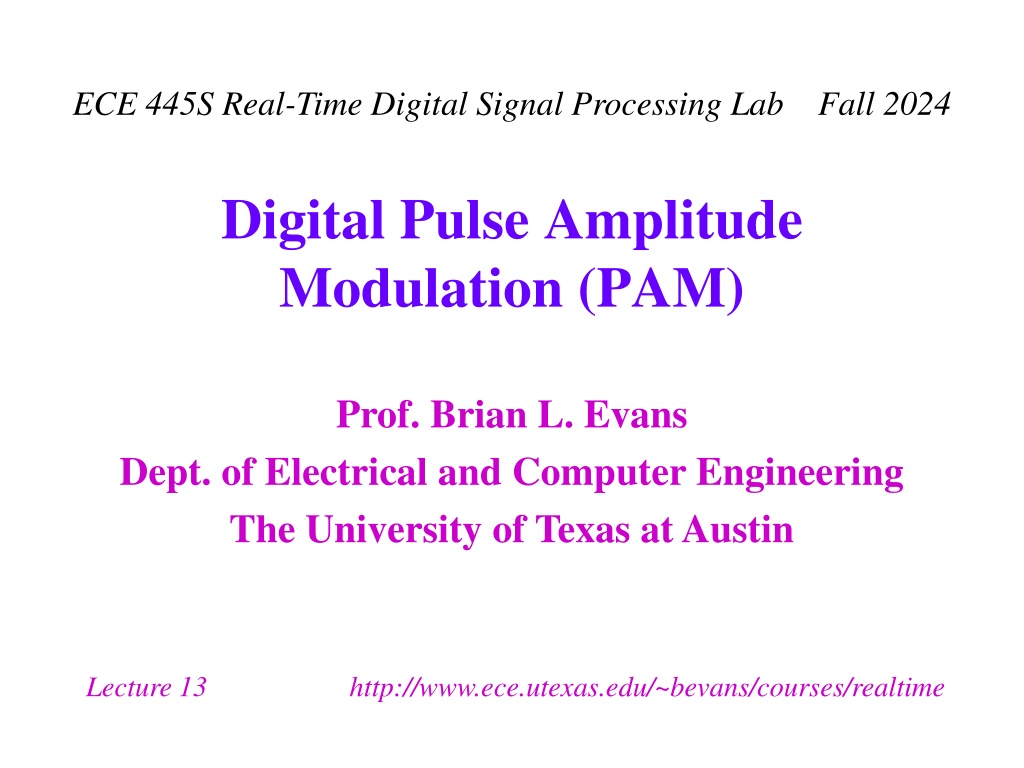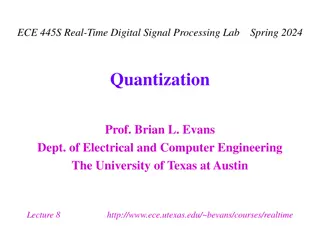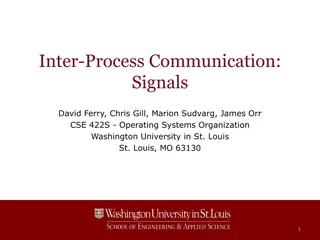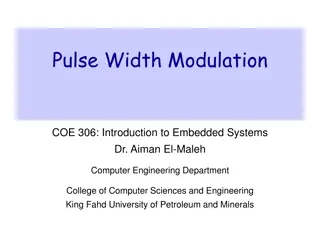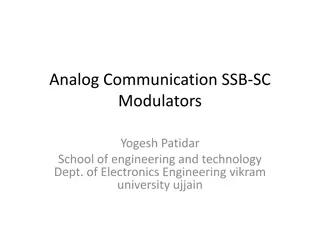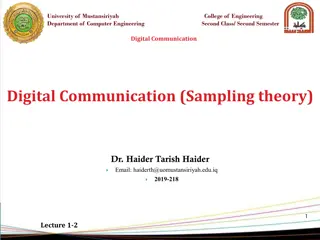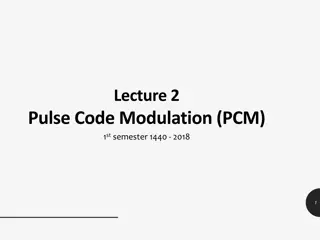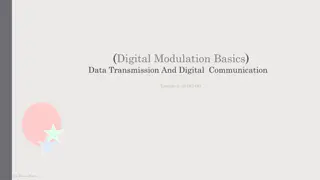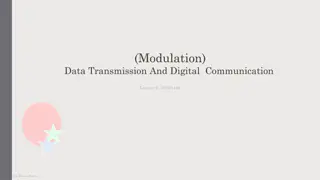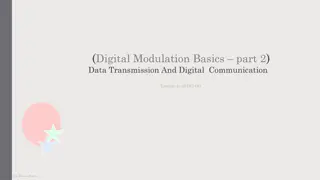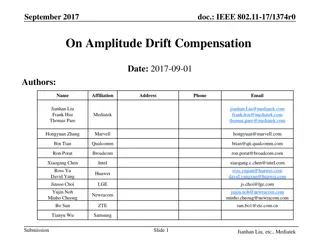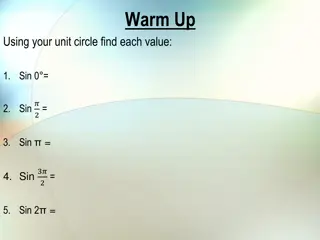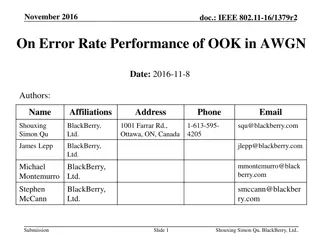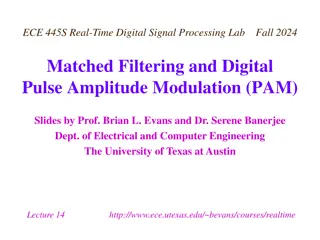Real-Time Digital Signal Processing Lab: Digital Pulse Amplitude Modulation (PAM)
Introduction to Digital Pulse Amplitude Modulation (PAM) in the context of Real-Time Digital Signal Processing Lab. Topics covered include pulse shaping, symbol mapping, baseband PAM transmission, and more. The content delves into bit-to-symbol conversion, symbol amplitude mapping, symbol period determination, 2-PAM transmission, and baseband PAM signal generation. Prof. Brian L. Evans of the University of Texas at Austin explains key concepts and techniques in this informative lecture.
- Digital Signal Processing
- Pulse Amplitude Modulation
- Real-Time Lab
- University of Texas
- Prof. Brian L. Evans
Download Presentation

Please find below an Image/Link to download the presentation.
The content on the website is provided AS IS for your information and personal use only. It may not be sold, licensed, or shared on other websites without obtaining consent from the author. Download presentation by click this link. If you encounter any issues during the download, it is possible that the publisher has removed the file from their server.
E N D
Presentation Transcript
ECE 445S Real-Time Digital Signal Processing Lab Fall 2024 Digital Pulse Amplitude Modulation (PAM) Prof. Brian L. Evans Dept. of Electrical and Computer Engineering The University of Texas at Austin Lecture 13 http://www.ece.utexas.edu/~bevans/courses/realtime
Outline Introduction Pulse shaping Pulse shaping filter bank Design tradeoffs FIR 0 Symbol clock recovery FIR 1 FIR L-1 13 - 2
Introduction symbol of bits symbol ampl. 3d 01 Convert bit stream into pulse stream Group stream of bits into symbols of J bits Map symbol of bits to unique amplitude Convert from discrete-time to continuous-time d 00 d 10 3d 11 M-level PAM or simply M-PAM (M = 2J) Symbol period is Tsym and bit rate is J fsym Interpolation pulseshape gTsym(t) per slide 7-6 4-level PAM Constellation Map d is a voltage Serial/ Parallel Discrete-to-Continuous Time Conversion (Interpolation) Map to PAM constellation an s*(t) baseband waveform 1 J bit symbol amplitude J bits per symbol ( ) = * ( ) a T s t g t k stream k T sym sym = k 13 - 3
2-PAM Transmission 2-PAM example (right) Truncated raised cosine pulse gTsym(t) with peak of 1 What are d and Tsym ? Max amplitude depends on d? Highest frequency fsym Alternating symbol amplitudes +d, -d, +d, which is d cos( n) Serial/ Parallel Discrete-to-Continuous Time Conversion (Interpolation) Map to PAM constellation an s*(t) baseband waveform 1 J bit symbol amplitude J bits per symbol ( ) = * ( ) a T s t g t k stream k T sym sym = k 13 - 4
Baseband PAM Transmission Code % Discrete-time baseband PAM signal mmax = N*L; v = zeros(1,mmax); v(1:L:end) = symAmp; % interpolation s = conv(v, g); slength = length(s); % trim result s = s(midpt+1:slength-midpt+1); % Interpretation in continuous time Tsym = 4; % Symbol period in sec fsym = 1/Tsym; % Symbol rate in Hz fs = L*fsym; % Sampling rate in Hz Ts = 1/fs; % Sampling time in sec % Baseband PAM Signal Generation % by Prof. Brian L. Evans % The University of Texas at Austin % Spring 2018 % % m is sample index % n is symbol index % Simulation parameters N = 25; % Number symbol periods % pulse shaping % Pulse shape g[m] Ng = 4; % Number symbol periods L = 20; % Samples/symbol period f0 = 1/L; midpt = Ng*L/2; m = (-midpt) : (midpt-1); g = sinc(f0*m); % Plots Mmax = length(s); m = 0 : (Mmax-1); t = m*Ts; Nmax = Mmax / L; n = 0 : (Nmax-1); figure; plot(t,s); hold on; stem(n*Tsym,symAmp); hold off; xlim( [0 (Nmax-(Ng/2))*Tsym-Ts] ); ymax = Ng * (M-1) * d / 2; ylim( [-ymax ymax] ); xlabel('Time (ms)'); title('Baseband PAM Signal s(t)'); % Adjust for group delay N = N + (Ng/2); % M-level PAM symbol amplitudes d = 1; M = 2; ioffset = M + 1; symAmp = (2*randi(M,[1,N]) - ioffset)*d; 13 - 5
4-PAM Transmission 4-PAM example (right) Truncated raised cosine pulse gTsym(t) with peak of 1 What are d and Tsym ? Max amplitude depends on d? Highest frequency fsym Alternating symbol amplitudes +d, -d, +d, ... or +3d, -3d, +3d, ... Serial/ Parallel Discrete-to-Continuous Time Conversion (Interpolation) Map to PAM constellation an s*(t) baseband waveform 1 J bit symbol amplitude J bits per symbol ( ) = * ( ) a T s t g t k stream k T sym sym = k 13 - 6
PAM Transmission Convert baseband processing to discrete time Pulse shaper gTsym[m] Serial/ Parallel Map to PAM constellation L D/A an 1 J s*(t) s*[i] baseband waveform J bits per symbol @fsym bit symbol amplitude @fsym fs = Lfsym fs stream @fs @fs = + = + * [ ] [ ( L ) ] s Ln m a g n k m k sym T k Sample at sampling time Ts : let t = (nL + m) Ts L samples per symbol period Tsymi.e. Tsym = LTs n is the index of the current symbol period being transmitted m is a sample index within nth symbol (i.e., m= 0, 1, , L-1)
PAM Transmission Derivation of s*[Ln + m] expression on previous slide 13 - 8
Digital Interpolation Example Input to Upsampler by 4 16 bits 44.1 kHz 28 bits 176.4 kHz 16 bits 176.4 kHz FIR Filter 4 n 0 1 2 Digital Audio 4x Oversampling Filter Output of Upsampler by 4 Upsampling by 4 (denoted by L) Output input sample followed by 3 zeros Four times samples on output as input Increases sampling rate by factor of 4 FIR interpolation filter (lowpass) Prior to upsampling, fmaxis 22.05 kHz At filter input, max= 2 fmax/ fs = / 4 = / L Filter specifications: stop < / 4 and pass = 0.9 stop n 0 1 2 3 4 5 6 7 8 Output of FIR Filter n 0 1 2 3 4 5 6 7 8 FIR fills in zero values 13 - 9
PAM Transmission Example Fall 2021 Midterm #2 13 - 10
Filter Bank Example #1 Avoid multiplying by and storing inserted 0 samples Pulse shape g[m] lasts 2 symbols (8 samples; L = 4) a2a1a0 000a1000a0 x[m] bits encoding g[m] 4 s[m] s[m] = x[m] * g[m] s[0] = a0 g[0] s[1] = a0g[1] s[2] = a0g[2] s[3] = a0g[3] s[4] = a0g[4] + a1g[0] s[5] = a0g[5] + a1g[1] s[6] = a0g[6] + a1g[2] s[7] = a0g[7] + a1g[3] L polyphase filters operating at symbol rate ,s[4],s[0] m=0 {g[0],g[4]} ,s[5],s[1] Filter Bank a2a1a0 {g[1],g[5]} s[m] ,s[6],s[2] {g[2],g[6]} ,s[7],s[3] Commutator (Periodic) {g[3],g[7]}
Filter Bank Example #2 24 samples in pulse L = 4 samples per symbol Ng = 6 symbol periods/pulse Polyphase filter 0 impulse response is first sample of the pulse shape and every Lth sample after that Polyphase filter 0 has only one non-zero sample. 13 - 12
Filter Bank Example #2 24 samples in pulse L = 4 samples per symbol Ng = 6 symbol periods/pulse Polyphase filter 1 impulse response is second sample of the pulse shape and every Lth sample after that 13 - 13
Filter Bank Example #2 24 samples in pulse L = 4 samples per symbol Ng = 6 symbol periods/pulse Polyphase filter 2 impulse response is third sample of the pulse shape and every Lth sample after that 13 - 14
Filter Bank Example #2 24 samples in pulse L = 4 samples per symbol Ng = 6 symbol periods/pulse Polyphase filter 3 impulse response is fourth sample of the pulse shape and every Lth sample after that 13 - 15
Pulse Shaping Design Tradeoffs Computation in MACs/s Memory size in words Memory reads in words/s Memory writes in words/s Direct structure (slide 13-9) Filter bank structure (slide 13-12) (L Ng)(Lfsym) LNg fsym fsym symbol rate L samples/symbol Ng duration of pulse shape in symbol periods 13 - 16
Pulse Shaping Design Tradeoffs FIR filter with N coefficients to compute output Read current input value x[n] Read pointer to newest input sample in circular buffer Read previous N-1 input values Read N filter coefficients h Compute the output value y[n] Write current input value to circular buffer to oldest sample Write (update) the newest pointer in circular buffer Write output value N multiplications-additions, 2N + 1 reads, 3 writes N-1 y[n]= h[m] x[n-m] m=0 13 - 17
Pulse Shaping Design Tradeoffs Direct structure (slide 13-9) FIR filter has L Ng coefficients (N = L Ng) FIR filter: N multiplications-additions, 2N + 1 reads, 3 writes FIR filter runs at sampling rate Lfsym Upsampler reads at symbol rate and writes at sampling rate Filter bank structure (slide 13-9) L polyphase FIR filters with Ng coefficients each FIR filter: Ng multiplications-additions, 2Ng + 1 reads, 3 writes Each polyphase FIR filter runs at symbol rate fsym Commutator reads and writes at sampling rate Lfsym 13 - 18
